| Listing 1 - 10 of 10 |
Sort by
|
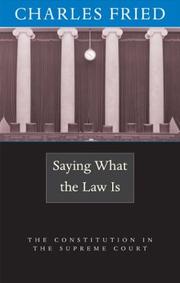
ISBN: 0674013026 Year: 2004 Publisher: London Cambridge, Mass. Harvard University Press
Abstract | Keywords | Export | Availability | Bookmark
 Loading...
Loading...Choose an application
- Reference Manager
- EndNote
- RefWorks (Direct export to RefWorks)
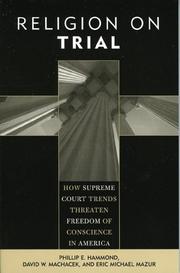
ISBN: 0759106010 Year: 2004 Publisher: Walnut Creek New York [etc.] AltaMira
Abstract | Keywords | Export | Availability | Bookmark
 Loading...
Loading...Choose an application
- Reference Manager
- EndNote
- RefWorks (Direct export to RefWorks)

ISBN: 0700613471 Year: 2004 Publisher: Lawrence University Press of Kansas
Abstract | Keywords | Export | Availability | Bookmark
 Loading...
Loading...Choose an application
- Reference Manager
- EndNote
- RefWorks (Direct export to RefWorks)
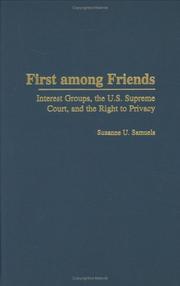
ISBN: 0275978249 Year: 2004 Publisher: Westport London Praeger
Abstract | Keywords | Export | Availability | Bookmark
 Loading...
Loading...Choose an application
- Reference Manager
- EndNote
- RefWorks (Direct export to RefWorks)
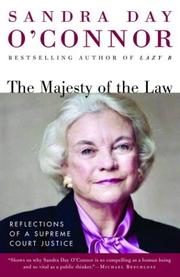
ISBN: 081296747X Year: 2004 Publisher: New York Random House
Abstract | Keywords | Export | Availability | Bookmark
 Loading...
Loading...Choose an application
- Reference Manager
- EndNote
- RefWorks (Direct export to RefWorks)
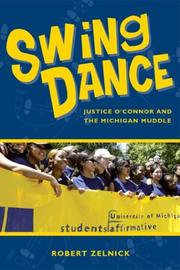
ISBN: 0817945229 Year: 2004 Publisher: Stanford Hoover Institution Press
Abstract | Keywords | Export | Availability | Bookmark
 Loading...
Loading...Choose an application
- Reference Manager
- EndNote
- RefWorks (Direct export to RefWorks)

ISBN: 0195129032 Year: 2004 Publisher: Oxford : Oxford university press,
Abstract | Keywords | Export | Availability | Bookmark
 Loading...
Loading...Choose an application
- Reference Manager
- EndNote
- RefWorks (Direct export to RefWorks)
Segregation --- Law and legislation --- History. --- United States --- History --- Race relations --- United States. Supreme Court
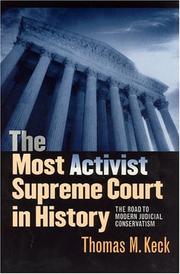
ISBN: 0226428869 9786612537738 1282537733 9780226428864 9780226428840 0226428842 0226428842 0226428850 6612537736 9781282537736 Year: 2004 Publisher: Chicago : University of Chicago Press,
Abstract | Keywords | Export | Availability | Bookmark
 Loading...
Loading...Choose an application
- Reference Manager
- EndNote
- RefWorks (Direct export to RefWorks)
When conservatives took control of the federal judiciary in the 1980s, it was widely assumed that they would reverse the landmark rights-protecting precedents set by the Warren Court and replace them with a broad commitment to judicial restraint. Instead, the Supreme Court under Chief Justice William Rehnquist has reaffirmed most of those liberal decisions while creating its own brand of conservative judicial activism. Ranging from 1937 to the present, The Most Activist Supreme Court in History traces the legal and political forces that have shaped the modern Court. Thomas M. Keck argues that the tensions within modern conservatism have produced a court that exercises its own power quite actively, on behalf of both liberal and conservative ends. Despite the long-standing conservative commitment to restraint, the justices of the Rehnquist Court have stepped in to settle divisive political conflicts over abortion, affirmative action, gay rights, presidential elections, and much more. Keck focuses in particular on the role of Justices O'Connor and Kennedy, whose deciding votes have shaped this uncharacteristically activist Court.
Conservatism --- Law --- Law and politics --- Political aspects. --- Rehnquist, William H., --- Rehnquist, Bill, --- United States. --- Supreme Court (U.S.) --- Chief Justice of the United States --- Supreme Court of the United States --- 美國. --- United States. Supreme Court --- Rehnquist, William Hubbs --- United States --- activism, courtroom, historical, contemporary, laws, legal, legality, lawyer, conservative, politics, political, federal, judiciary, 1980s, history, rights, precedents, warren, restraint, progress, liberal, 1930s, 1940s, 1950s, 1960s, 1970s, 1990s, 2000s, modern, justices, o connor, kennedy, reagan, president, presidential, nixon, rehnquist.
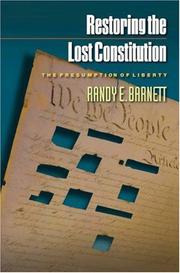
ISBN: 0691115850 140084813X 0691159734 1306129478 Year: 2004 Publisher: Princeton Oxford Princeton University Press
Abstract | Keywords | Export | Availability | Bookmark
 Loading...
Loading...Choose an application
- Reference Manager
- EndNote
- RefWorks (Direct export to RefWorks)
The U.S. Constitution found in school textbooks and under glass in Washington is not the one enforced today by the Supreme Court. In Restoring the Lost Constitution, Randy Barnett argues that since the nation's founding, but especially since the 1930's, the courts have been cutting holes in the original Constitution and its amendments to eliminate the parts that protect liberty from the power of government. From the Commerce Clause, to the Necessary and Proper Clause, to the Ninth and Tenth Amendments, to the Privileges or Immunities Clause of the Fourteenth Amendment, the Supreme Court has rendered each of these provisions toothless. In the process, the written Constitution has been lost. Barnett establishes the original meaning of these lost clauses and offers a practical way to restore them to their central role in constraining government: adopting a "presumption of liberty" to give the benefit of the doubt to citizens when laws restrict their rightful exercises of liberty. He also provides a new, realistic and philosophically rigorous theory of constitutional legitimacy that justifies both interpreting the Constitution according to its original meaning and, where that meaning is vague or open-ended, construing it so as to better protect the rights retained by the people. As clearly argued as it is insightful and provocative, Restoring the Lost Constitution forcefully disputes the conventional wisdom, posing a powerful challenge to which others must now respond. This updated edition features an afterword with further reflections on individual popular sovereignty, originalist interpretation, judicial engagement, and the gravitational force that original meaning has exerted on the Supreme Court in several recent cases.
Constitutional history --- United States --- Constitutional law --- Judicial review --- United States. Supreme Court --- United States. --- Supreme Court (U.S.) --- Chief Justice of the United States --- Supreme Court of the United States --- 美國. --- Commerce Clause. --- Congress. --- Constitution in Exile movement. --- Constitution. --- Due Process Clauses. --- First Amendment. --- Footnote Four. --- Fourteenth Amendment. --- Gibbons v. Ogden. --- John Marshall. --- Lawrence v. Texas. --- Necessary and Proper Clause. --- Ninth Amendment. --- Presumption of Liberty. --- Privileges or Immunities Clause. --- Slaughter-House Cases. --- Supreme Court. --- U.S. Constitution. --- We the People. --- commerce. --- consent of the governed. --- consent. --- constitutional interpretation. --- constitutional law. --- constitutional legitimacy. --- constitutional meaning. --- constitutional scholarship. --- construction. --- democracy. --- divine right. --- economic liberty. --- federal courts. --- federal laws. --- federal power. --- government. --- immunities. --- interpretation. --- judges. --- judicial doctrines. --- judicial nullification. --- judicial power. --- judicial review. --- judicial supremacy. --- law. --- laws. --- legislation. --- legislative activism. --- liberty rights. --- liberty. --- majoritarianism. --- natural rights. --- necessary and proper. --- necessity. --- original intent. --- original meaning. --- originalism. --- police power. --- popular sovereignty. --- presumed consent. --- presumption of constitutionality. --- privileges. --- proper. --- rights. --- state laws. --- state power. --- unconstitutional laws. --- unenumerable rights. --- unenumerated rights.
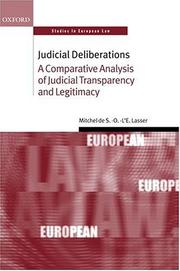
ISBN: 9780199575169 9780199274123 0199575169 1306134854 0199274126 Year: 2004 Publisher: Oxford: Oxford university press,
Abstract | Keywords | Export | Availability | Bookmark
 Loading...
Loading...Choose an application
- Reference Manager
- EndNote
- RefWorks (Direct export to RefWorks)
Judicial Deliberations compares how and why the European Court of Justice, the French Cour de cassation and the US Supreme Court offer different approaches for generating judicial accountability and control, judicial debate and deliberation, and ultimately judicial legitimacy. Examining the judicial argumentation of the United States Supreme Court and of the French Cour de cassation, the book first reorders the traditional comparative understanding of the difference between French civil law and American common law judicial decision-making. It then uses this analysis to offer the first detailed comparative examination of the interpretive practice of the European Court of Justice. Lasser demonstrates that the French judicial system rests on a particularly unified institutional and ideological framework founded on explicitly republican notions of meritocracy and managerial expertise. Law-making per se may be limited to the legislature; but significant judicial normative administration is entrusted to State selected, trained, and sanctioned elites who are policed internally through hierarchical institutional structures. The American judicial system, by contrast, deploys a more participatory and democratic approach that reflects a more populist vision. Shunning the unifying, controlling, and hierarchical French structures, the American judicial system instead generates its legitimacy primarily by argumentative means. American judges engage in extensive debates that subject them to public scrutiny and control. The ECJ hovers delicately between the institutional/argumentative and republican/democratic extremes. On the one hand, the ECJ reproduces the hierarchical French discursive structure on which it was originally patterned. On the other, it transposes this structure into a transnational context of fractured political and legal assumptions. This drives the ECJ towards generating legitimacy by adopting a somewhat more transparent argumentative approach.
Judicial process --- Processus judiciaire --- France. --- United States. --- Court of Justice of the European Communities. --- -Judicial process --- -347.012094 --- Me1 --- Decision making, Judicial --- Judicial behavior --- Judicial decision making --- Judges --- Law --- Procedure (Law) --- Psychological aspects --- Interpretation and construction --- France. -- Cour de cassation. --- Judicial process -- European Union countries. --- Judicial process -- France. --- Judicial process -- United States. --- United States. -- Supreme Court. --- Law, General & Comparative --- Law - Europe, except U.K. --- Law - Non-U.S. --- Law, Politics & Government --- Judicial assistance. --- Supreme Court (U.S.) --- Chief Justice of the United States --- Supreme Court of the United States --- Judicial assistance --- Civil procedure --- Criminal procedure --- Judgments, Foreign --- Cour de justice des communautés européennes --- Gerichtshof der Europäischen Gemeinschaften --- Corte di giustizia delle comunità europee --- Dikastērion tēs Europaikēs Oikonomikēs Koinotētos --- Hof van Justitie van de Europese Gemeenschappen --- Tribunal de Justicia de las Comunidades Europeas --- GHEG --- European Atomic Energy Community. --- European Economic Community. --- European Court of Justice --- Europäischer Gerichtshof --- Curtea de Justiție a Comunităților Europene --- Ōshū Shihō Saibansho --- G.H.E.G. --- Tribunal de Justiça das Comunidades Europeias --- Sud evropeĭskikh soobshchestv --- Avrupa Toplulukları Adalet Divanı --- Tribunal de Justiça das Comunidades --- Curia Communitatum Europaearum --- Eurōpaiko Dikastērio --- Dikastērio Eurōpaikōn Koinotētōn --- DEK --- EuGH --- ECJ --- D.E.K. --- Europejski Trybunał Sprawiedliwości --- ETS --- Dikastērio tōn Eurōpaikōn Koinotētōn --- CEJ --- European Union. --- European Coal and Steel Community. --- Court of Justice of the European Union --- 美國. --- Court of Justice of the European Communities --- Európai Bíróság --- Judicial process - European Union countries --- Judicial process - France --- Judicial process - United States --- DROIT JUDICIAIRE COMPARE --- Cour suprême --- COMMON LAW --- COUR DE CASSATION --- Cour de justice des Communautés européennes --- Etats-Unis --- FRANCE --- question préjudicielle
| Listing 1 - 10 of 10 |
Sort by
|

 Search
Search Feedback
Feedback About UniCat
About UniCat  Help
Help News
News